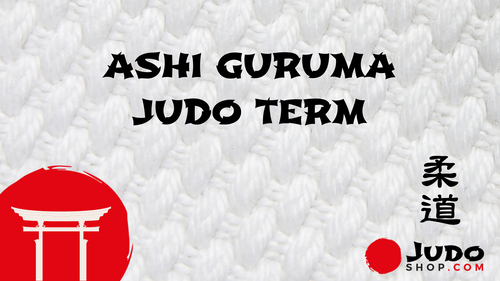Ashi Garami - Judo Term Explained
Share

What does "Ashi garami" mean in Judo?
"Ashi garami" (足緘) is a Japanese term used in Judo that literally translates to "entangled leg lock". It refers to a joint lock submission technique that targets the knee by twisting and entangling the legs.
The term breaks down as follows:
- Ashi (足) means foot or leg
- Garami (緘) means entanglement
So together, "ashi garami" describes a leg entanglement technique. In Judo, it specifically refers to a twisting leglock that puts pressure on the knee joint.
What are the origins of ashi garami in Judo history?
Ashi garami has been part of Judo since the early days of the art in the late 19th century. It was originally included in the Kodokan curriculum by Judo's founder Jigoro Kano.
However, the technique was banned from Judo competition in 1916 after several injuries occurred. A famous incident involved a judoka getting his leg broken while the Emperor Taisho was watching a Judo demonstration in 1898. This led to ashi garami being prohibited to avoid such gruesome injuries.
Despite the competition ban, ashi garami continued to be taught and practiced as part of Judo's self-defense curriculum. It is still included in some Kodokan kata (pre-arranged forms) to this day.
How is ashi garami applied in Judo?
The ashi garami technique is applied from the ground, usually when the opponent is lying face-down. The attacker entangles one of their legs around one of the defender's legs, and then grabs the entangled leg with their arms.
By twisting their body and pulling on the leg, the attacker puts severe twisting pressure on the knee joint. If the defender does not submit, their knee can easily be popped or hyperextended.
Here is a step-by-step breakdown of applying ashi garami:
- With the opponent face-down, thrust both legs between their legs
- Rotate your body to scissor one of their legs between your own legs
- Grab their entangled leg tightly with your arms
- Twist your whole body while maintaining the leg entanglement
- Clamp your feet below their waist for added leverage
- Pull their leg forward to apply strong pressure to the knee
Why is ashi garami banned in Judo competition?
Ashi garami is one of the most dangerous submission techniques in Judo. It puts extreme twisting force on the knee joint, which can easily cause severe ligament tears, dislocations, and even bone fractures if applied suddenly or forcefully.
Strikes, joint locks, and other dangerous techniques are prohibited in Judo competition to minimize injury risk to the participants. Only armlocks and chokes are allowed.
Since ashi garami has a high probability of causing major knee trauma, it is considered too risky for competition. Judo is meant to be a relatively safe combat sport, so techniques like ashi garami and leg locks in general are banned.
What other leg locks are used in Judo?
While ashi garami specifically is prohibited in Judo, there are a few other leg lock techniques that are part of Judo's traditional syllabus:
| Japanese Term | English Translation |
|---|---|
| Ashi hishigi | Achilles lock |
| Ashi dori garami | Toe hold |
| Hiza juji gatame | Knee bar |
However, all leg locks are currently banned in Judo competition, not just ashi garami. They are still practiced in some dojos for self-defense purposes though.
How does ashi garami compare to other martial arts?
Unlike Judo, some other grappling martial arts make extensive use of leg locks, including variations of ashi garami. Notable examples include:
- Brazilian Jiu-Jitsu: BJJ focuses heavily on ground grappling and submission holds. Ashi garami is a core technique, usually called the "411" or "honey hole" position. Sambo and Catch Wrestling also use ashi garami.
- Kosen Judo: A ruleset of Judo popular in early 20th century Japan that had no restrictions on leg locks. It allowed a greater variety of ne-waza (ground techniques) compared to mainstream Kodokan Judo.
- Mixed Martial Arts (MMA): With its amalgamation of techniques from various martial arts, MMA competition has no restrictions on leg locks. Many MMA fighters have won bouts using ashi garami and other leg attacks.
So while ashi garami may be banned in modern Judo competition, it lives on in other combat sports and self-defense systems around the world. Its exclusion from Judo is a result of the art's sportification and desire to limit injury.
What is the significance of ashi garami in Judo culture?
Despite its ban in shiai (competition), ashi garami holds an important place in Judo history and tradition. It exemplifies the original self-defense roots of the art.
Ashi garami also represents the divergence between Kano's vision of Judo as a holistic lifestyle and the modern sporting approach. Techniques like ashi garami are preserved in kata practice as examples of "real world" combat applications.
For many old-school judoka, ashi garami symbolizes the early days of Judo, before rules and restrictions narrowed the art's scope. It is a remnant of Judo's rougher, more martial past.
At the same time, the prohibition of ashi garami can be seen as part of Judo's evolution into a safe, accessible, and widely-practiced physical education system and Olympic sport. The ban shows Judo's commitment to prioritizing athlete safety.
Conclusion
In summary, ashi garami is a dangerous yet iconic leg lock technique in Judo. With roots going back to the very founding of the art, it was eventually banned from competition due to its high risk of causing severe knee injuries.
Nevertheless, ashi garami is still practiced by some judoka and maintains an important legacy in Judo history and culture. It embodies Judo's complex identity as both a traditional martial art and a modern combat sport.
While you won't see ashi garami in Olympic Judo matches any time soon, its influence can be felt in the leg lock techniques of other grappling arts like BJJ and Sambo. The ashi garami ban is a testament to Judo's ongoing balancing act between tradition and evolution.
Related Posts
-

Kayla Harrison's Judo Journey - Judo Champion Turned MMA Powerhouse
Kayla Harrison is a groundbreaking American judoka who made history by becoming the first American woman to win an Ol...
-

Judo Atlanta - List of Judo Clubs in Atlanta area
In Atlanta, you can find excellent judo clubs such as Atlanta Judo Midtown and Black Ice Fitness where you can train...
-

Guram Tushishvili Disqualified - JUDO DRAMA with Teddy Riner
Guram Tushishvili Disqualified - Unsportsmanlike Behavior to French Judoka Teddy Riner Leads to Disqualification fro...
-

Yeldos Smetov - Judoka Profile
Yeldos Smetov, a name synonymous with excellence in judo, has carved out an illustrious career that stands as a beac...
-

Judo Olympics 2024 Results - Gold, Silver, and Bronze Medalists
The Judo Olympics 2024 Results are eagerly anticipated as the Paris Games approach, promising a thrilling display...
-

Judo For Self Defense - Here Is Why Is Judo Best For Self-Defense
Judo For Self Defense packs a punch. This martial art, born in Japan, turns attackers' strength against them. No nee...
-

Ashi Hara Gatame - Judo Term Explained
Ashi Hara Gatame is a specialized technique in the martial art of judo, combining leg control, abdominal pressure, a...
-

Ashi Gatame - Judo Term Explained
Ashi Gatame is a Judo technique referring to a kansetsu-waza (joint lock) where one uses their legs to immobilise ...
-

Judo Olympics 2024: Highlights, Athletes, and Schedules
Judo Olympics 2024 enthusiasts, mark your calendars! From July 27 to August 3, the Grand Palais Éphémère near the Eif...
-

Ashi - Judo Term Explained
Ashi is term in Judo, referring to a leg or foot and category of judo techniques designed to unbalance and throw an ...
-

Anza - Judo Term Explained
The term Anza in Judo (安座) embodies a significant practice beyond merely sitting; it signals a deep respect and disc...
-

Ashi Guruma - Judo Term Explained
Ashi Guruma is a Judo term rooted in the martial art of Judo, which translates from Japanese as 'leg wheel'. This ju...
-

Judo vs BJJ? Of course Judo! Judo is better!
Welcome to Judoshop.com, the premier destination for judo enthusiasts worldwide. Here, we cater to beginners and vet...
-

Hantei Judo Term Explanation
Contrary to popular belief, the term 'Hantei' in Judo is not just a simple decision-making process. It holds the p...
-

Dojo Meaning (updated 2023)
Dojos, places of immersive learning and meditation, hold great significance in martial arts. Derived from the Japane...
-

Hajime - Judo Term Explained
Ready to learn about Hajime in judo?It's all about using throws, pins, and joint locks on the mat. With the command ...
-

Ayumi Ashi - Judo Foot Work Explained
Are you ready to step into the world of Judo and master the art of Ayumi Ashi - 歩み足? This fundamental footwork techn...
-

Bushido Explained
Bushido, the traditional code of ethics followed by samurai warriors in feudal Japan, is a subject that fascinates ...
-

Ippon - Judo Term Explained
Imagine stepping onto the mat and feeling the adrenaline rush through your veins. In the world of judo, one ultimate...
-

Budo - Term Explained
In a world full of chaos and conflict, one finds solace in the ancient art of budo. Contrary to popular belief, budo...
-

Arigatou - Judo Term Explained
Do you ever wonder about the true meaning behind the Japanese word 'Arigatou'? Well, wonder no more! 'Arigatou' is a...
-

Aka Obi - Judo Term Explained
The aka obi, a red belt worn in Judo, is a prestigious symbol of expertise. Typically reserved for those holding a 9...
-

Why Are There 2 Bronze Medals In Judo
Judo is a unique sport that gives two bronze medals in each weight class. Many people wonder why this is done. To fi...
-

Ai Yotsu - Judo Term Explained
In the world of Judo, a term holds immense significance - Ai Yotsu. This grip, characterized by an intense and intim...
-

Is Judo Dangerous - Unveiling the Shocking Truths Behind this Ancient Martial Art
With its powerful throws and complex grappling techniques, one might wonder, "Is judo dangerous?" Yes, judo can po...
-

Is Judo The Toughest Sport - Unraveling the Grit and Grace of the Gentle Way
Judo, known as the Gentle Way, may seem like a paradoxical name for a sport, but don't let that fool you. While Ju...
-

Judo Terms - Complete List Of Judo Terms
Judo terms are the foundation of this martial art...
-

English to Japanese Kanji and Hiragana translations
Are you looking for an English to Japanese Kanji translation? Here you can find more than 30 examples of Kanji and ...




























